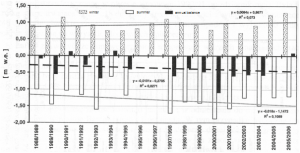Glacier mass balance
The difference between the amount of accumulation and ablation of a glacier. It can be measured over one year (annual mass balance) or over several years (long-term mass balance).
The most common mass balance measurement is carried out over one hydrologic year.
The beginning and end of the hydrologic year are determined by two consecutive minima: the end of the largest decrease of the surface mass of the glacier, which happens at the end of the period when ablation occurs (summer period).
The hydrologic year is divided into two parts: the “ACCUMULATION” period (winter period), when show falls on the glacier and builds up ice mass on its top (usually starting from August or September), and the “ABLATION” period (summer period), when the glacier begins to lose mass after the last spring snowfall in April/May).
The position of the glacier’s surface is measured over both the accumulation and ablation periods, which means measurements are taken twice a year, using ablation stakes.



 This project (EDU-ARCTIC) has received funding from the European Union’s Horizon 2020 research and innovation programme under grant agreement No 710240. The content of the website is the sole responsibility of the Consortium and it does not represent the opinion of the European Commission, and the Commission is not responsible for any use that might be made of information contained.
This project (EDU-ARCTIC) has received funding from the European Union’s Horizon 2020 research and innovation programme under grant agreement No 710240. The content of the website is the sole responsibility of the Consortium and it does not represent the opinion of the European Commission, and the Commission is not responsible for any use that might be made of information contained.